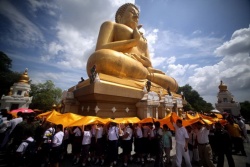Difference between revisions of "Analysis of experience"
(Created page with " Analysis of Experience by Madawela Punnaji, M.D. Normally, we experience "existence" when we think in terms of an existing "experiencer" experie...") |
|||
| (3 intermediate revisions by the same user not shown) | |||
| Line 1: | Line 1: | ||
| + | <nomobile>{{DisplayImages|561|1679|1304}}</nomobile><nomobile>{{DisplayImages|3572|2499}}</nomobile> | ||
| Line 4: | Line 5: | ||
| + | Analysis of [[Experience]] by [[Madawela Punnaji]], M.D. | ||
| − | + | Normally, we [[experience]] "[[existence]]" when we think in terms of an [[existing]] "[[experiencer]]" experiencing the [[existing]], "[[object]] of [[experience]]". | |
| + | |||
| + | There are three parts to that [[experience]] as follows: Experiencer___Experience___Experienced ([[Subject]]) ([[Object]]) The term "[[existence]]" ([[bhava]]) refers to the apparent [[existence]] of the "[[subject]]" and the "[[object]]" of [[experience]], on which are based all [[emotional]] relationships between the [[subject]] and the [[object]]. | ||
| + | |||
| + | The normal [[paradigm]] is the [[experience]] of the [[existence]] of a [[subject]] and an [[object]], and the relationship between them. | ||
| + | |||
| + | It is to think that there is a "[[subject]]" experiencing an "[[object]]" cognitively and affectively. | ||
| + | |||
| + | Through the [[vipassana meditation]] the [[meditator]] becomes {{Wiki|aware}} of this [[experience]] as only an "[[experience]]", instead of as a real "[[existence]]" and a relationship. | ||
| + | |||
| + | This means, the "[[existence]]" of the [[subject]] and the [[object]] is seen as an "[[experience]]" only, or as a mere product of the process of [[perception]], or of experiencing. | ||
| + | |||
| + | In other words, the [[subject]] and the [[object]] are seen as "creations of the [[mental]] process". | ||
| + | |||
| + | This means, the process of experiencing precedes the notion of the [[existence]] of [[subject]] and [[object]], not vise versa. | ||
| + | |||
| + | This may be stated as, "[[experience]] precedes [[existence]]". | ||
| + | |||
| + | It is [[seeing]] that "[[experience]]" is the [[Wikipedia:Absolute (philosophy)|ultimate]] foundation of "[[existence]]". | ||
| + | |||
| + | This uncommon [[paradigm]] may be called the "experiencing of [[experience]]" which is quite different from the common [[paradigm]] of the "[[experience]] of [[existence]]". | ||
| + | |||
| + | This is the [[paradigm]] shift from "[[existence]]" to "[[experience]]". | ||
| + | |||
| + | When this happens, all subject/object relationships are seen as meaningless. | ||
| + | |||
| + | This [[paradigm]] shift can take place only by [[letting go]] of all [[attachments]] to [[objects]] of [[experience]], the subjectively [[experienced]] "[[self]]", and all relationships, through depersonalization. | ||
| + | |||
| + | This [[paradigm]] shift is the freedom from the [[experience]] of [[existence]], and all the [[suffering]] accompanying it. | ||
| + | |||
| + | This is called the "[[cessation]] of [[existence]]" ([[bhava]] [[nirodha]]). | ||
| − | + | When this happens, all [[sufferings]], {{Wiki|fears}}, worries and anxieties come to an end. | |
| − | + | This is [[NIBBANA]], which has been defined by the [[Buddha]] as "the [[cessation]] of [[existence]]" ([[bhava]] nirodho nibbanam). | |
| − | This [[ | + | This [[cessation]] of [[existence]] is not a [[death]] but the freedom from the [[dream]] of [[existence]], which is an [[awakening]] to the [[reality]] of "{{Wiki|impersonal}} [[experience]]". |
| − | + | Therefore [[Nibbana]] ([[Nirvana]]) is the [[experience]] of the [[ultimate reality]] of {{Wiki|impersonal}} [[experience]]. This [[idea]] may be confusing at the beginning, but it becomes clearer as one advances in [[meditation]]. | |
[[Meditation]] is a Way of Living | [[Meditation]] is a Way of Living | ||
| − | Very often [[meditation]] is referred to as sitting. This again is a {{Wiki|misunderstanding}} due to the [[confusion]] of [[Buddhist meditation]] with the [[Zen practice]] of sitting called [[Zazen]]. It is important to {{Wiki|emphasize}} here that the original [[Buddhist meditation]] was not mere "sitting". [[Buddhist meditation]] is not a [[physical]] exercise but a [[mental]] {{Wiki|training}}. It is not inactivity or living in a [[trance]] like [[state]]. It is maintaining a [[pure]] and [[tranquil]] [[mind]] while in any [[posture]]. It can be done in all four [[postures]]: walking, [[standing]], sitting and {{Wiki|lying}} down. [[Buddhist meditation]] is an [[effort]] to change one's [[thinking]], [[feeling]] and {{Wiki|behaviour}}, through the [[constant practice]] of introspective [[awareness]] of one's [[thoughts]], [[feelings]], {{Wiki|speech}} and [[action]]. It is a different way of living. The main thing in [[Buddhist meditation]] is to practice the Super-normal Eight-fold Way. This way is usually translated as the [[Noble Eightfold Path]]. I find the former translation more meaningful. The [[Pali]] term "[[ariya]]" is usually translated as "[[noble]]" but it is translated here as "{{Wiki|supernormal}}" because the [[Buddha]] used this term "[[ariya]]" to refer to a special level of [[life]] above the normal, which he wanted his followers to rise to, in order to be free of normal [[unhappiness]]. The normal level of [[experience]] was called the "common folk's level" (putujjana [[bhumi]]), meaning ordinary level. The term that the [[Buddha]] used to refer to this [[teaching]] was "[[Ariya]] [[Dhamma]]", which means the "Supernormal [[Experience]]" (ariya=supernormal; dhamma=experience). When the [[Buddha]] used this term "[[ariya]]", he was not using this term as a {{Wiki|synonym}} for the {{Wiki|modern}} term "[[Buddhist]]". He was merely referring to a level of living above the normal. One who [[understands]] and practices [[the teaching of the Buddha]] is called an "[[ariya]] [[savaka]]", meaning the "hearer" of the Supernormal [[Experience]]. | + | Very often [[meditation]] is referred to as sitting. This again is a {{Wiki|misunderstanding}} due to the [[confusion]] of [[Buddhist meditation]] with the [[Zen practice]] of sitting called [[Zazen]]. |
| + | |||
| + | It is important to {{Wiki|emphasize}} here that the original [[Buddhist meditation]] was not mere "sitting". [[Buddhist meditation]] is not a [[physical]] exercise but a [[mental]] {{Wiki|training}}. | ||
| + | |||
| + | It is not inactivity or living in a [[trance]] like [[state]]. It is maintaining a [[pure]] and [[tranquil]] [[mind]] while in any [[posture]]. | ||
| + | |||
| + | It can be done in all four [[postures]]: walking, [[standing]], sitting and {{Wiki|lying}} down. | ||
| + | |||
| + | [[Buddhist meditation]] is an [[effort]] to change one's [[thinking]], [[feeling]] and {{Wiki|behaviour}}, through the [[constant practice]] of introspective [[awareness]] of one's [[thoughts]], [[feelings]], {{Wiki|speech}} and [[action]]. It is a different way of living. | ||
| + | |||
| + | The main thing in [[Buddhist meditation]] is to practice the Super-normal Eight-fold Way. | ||
| + | |||
| + | This way is usually translated as the [[Noble Eightfold Path]]. | ||
| + | |||
| + | |||
| + | I find the former translation more meaningful. | ||
| + | |||
| + | The [[Pali]] term "[[ariya]]" is usually translated as "[[noble]]" but it is translated here as "{{Wiki|supernormal}}" because the [[Buddha]] used this term "[[ariya]]" to refer to a special level of [[life]] above the normal, which he wanted his followers to rise to, in order to be free of normal [[unhappiness]]. The normal level of [[experience]] was called the "common folk's level" (putujjana [[bhumi]]), meaning ordinary level. | ||
| + | |||
| + | The term that the [[Buddha]] used to refer to this [[teaching]] was "[[Ariya]] [[Dhamma]]", which means the "Supernormal [[Experience]]" (ariya=supernormal; dhamma=experience). | ||
| + | |||
| + | When the [[Buddha]] used this term "[[ariya]]", he was not using this term as a {{Wiki|synonym}} for the {{Wiki|modern}} term "[[Buddhist]]". | ||
| + | |||
| + | He was merely referring to a level of living above the normal. | ||
| + | |||
| + | One who [[understands]] and practices [[the teaching of the Buddha]] is called an "[[ariya]] [[savaka]]", meaning the "hearer" of the Supernormal [[Experience]]. | ||
| + | |||
| + | In other words, what the [[Buddha]] meant by the term [[ariya]] was a higher level of growth of the [[human consciousness]]. | ||
| + | |||
| + | The aim of [[Buddhist meditation]] is to raise the [[human consciousness]] to a higher level. | ||
| + | |||
| + | Just as the aim of {{Wiki|modern}} {{Wiki|psychotherapy}} is to raise an abnormal [[person]] to a normal level of [[thinking]] and living, the aim of the [[Buddha]] was to bring the normal [[person]] to a super normal level of [[thinking]], [[feeling]] and living. It is important to understand this {{Wiki|distinction}}. | ||
| + | |||
| + | This is why the translation of the term "[[ariya]]" as Supernormal is preferable. This is why [[Buddhist meditation]] is here called a "growth technique", using a {{Wiki|modern}} [[psychological]] term. | ||
| − | + | By practicing [[Buddhist meditation]], one [[Wikipedia:Hope|hopes]] to grow to a higher level of [[emotional]] maturity, where one is free of normal [[unhappiness]]. | |
| − | + | This process of growth takes place according to a {{Wiki|natural law}}, and following a [[human]] technique. It doesn't happen automatically or through a [[supernatural power]]." | |
{{R}} | {{R}} | ||
http://www.dhammawiki.com/index.php?title=Analysis_of_experience | http://www.dhammawiki.com/index.php?title=Analysis_of_experience | ||
[[Category:Buddhist Philosophy]] | [[Category:Buddhist Philosophy]] | ||
Latest revision as of 12:05, 11 March 2016
Analysis of Experience by Madawela Punnaji, M.D.
Normally, we experience "existence" when we think in terms of an existing "experiencer" experiencing the existing, "object of experience".
There are three parts to that experience as follows: Experiencer___Experience___Experienced (Subject) (Object) The term "existence" (bhava) refers to the apparent existence of the "subject" and the "object" of experience, on which are based all emotional relationships between the subject and the object.
The normal paradigm is the experience of the existence of a subject and an object, and the relationship between them.
It is to think that there is a "subject" experiencing an "object" cognitively and affectively.
Through the vipassana meditation the meditator becomes aware of this experience as only an "experience", instead of as a real "existence" and a relationship.
This means, the "existence" of the subject and the object is seen as an "experience" only, or as a mere product of the process of perception, or of experiencing.
In other words, the subject and the object are seen as "creations of the mental process".
This means, the process of experiencing precedes the notion of the existence of subject and object, not vise versa.
This may be stated as, "experience precedes existence".
It is seeing that "experience" is the ultimate foundation of "existence".
This uncommon paradigm may be called the "experiencing of experience" which is quite different from the common paradigm of the "experience of existence".
This is the paradigm shift from "existence" to "experience".
When this happens, all subject/object relationships are seen as meaningless.
This paradigm shift can take place only by letting go of all attachments to objects of experience, the subjectively experienced "self", and all relationships, through depersonalization.
This paradigm shift is the freedom from the experience of existence, and all the suffering accompanying it.
This is called the "cessation of existence" (bhava nirodha).
When this happens, all sufferings, fears, worries and anxieties come to an end.
This is NIBBANA, which has been defined by the Buddha as "the cessation of existence" (bhava nirodho nibbanam).
This cessation of existence is not a death but the freedom from the dream of existence, which is an awakening to the reality of "impersonal experience".
Therefore Nibbana (Nirvana) is the experience of the ultimate reality of impersonal experience. This idea may be confusing at the beginning, but it becomes clearer as one advances in meditation. Meditation is a Way of Living
Very often meditation is referred to as sitting. This again is a misunderstanding due to the confusion of Buddhist meditation with the Zen practice of sitting called Zazen.
It is important to emphasize here that the original Buddhist meditation was not mere "sitting". Buddhist meditation is not a physical exercise but a mental training.
It is not inactivity or living in a trance like state. It is maintaining a pure and tranquil mind while in any posture.
It can be done in all four postures: walking, standing, sitting and lying down.
Buddhist meditation is an effort to change one's thinking, feeling and behaviour, through the constant practice of introspective awareness of one's thoughts, feelings, speech and action. It is a different way of living.
The main thing in Buddhist meditation is to practice the Super-normal Eight-fold Way.
This way is usually translated as the Noble Eightfold Path.
I find the former translation more meaningful.
The Pali term "ariya" is usually translated as "noble" but it is translated here as "supernormal" because the Buddha used this term "ariya" to refer to a special level of life above the normal, which he wanted his followers to rise to, in order to be free of normal unhappiness. The normal level of experience was called the "common folk's level" (putujjana bhumi), meaning ordinary level.
The term that the Buddha used to refer to this teaching was "Ariya Dhamma", which means the "Supernormal Experience" (ariya=supernormal; dhamma=experience).
When the Buddha used this term "ariya", he was not using this term as a synonym for the modern term "Buddhist".
He was merely referring to a level of living above the normal.
One who understands and practices the teaching of the Buddha is called an "ariya savaka", meaning the "hearer" of the Supernormal Experience.
In other words, what the Buddha meant by the term ariya was a higher level of growth of the human consciousness.
The aim of Buddhist meditation is to raise the human consciousness to a higher level.
Just as the aim of modern psychotherapy is to raise an abnormal person to a normal level of thinking and living, the aim of the Buddha was to bring the normal person to a super normal level of thinking, feeling and living. It is important to understand this distinction.
This is why the translation of the term "ariya" as Supernormal is preferable. This is why Buddhist meditation is here called a "growth technique", using a modern psychological term.
By practicing Buddhist meditation, one hopes to grow to a higher level of emotional maturity, where one is free of normal unhappiness.
This process of growth takes place according to a natural law, and following a human technique. It doesn't happen automatically or through a supernatural power."
Source
http://www.dhammawiki.com/index.php?title=Analysis_of_experience




